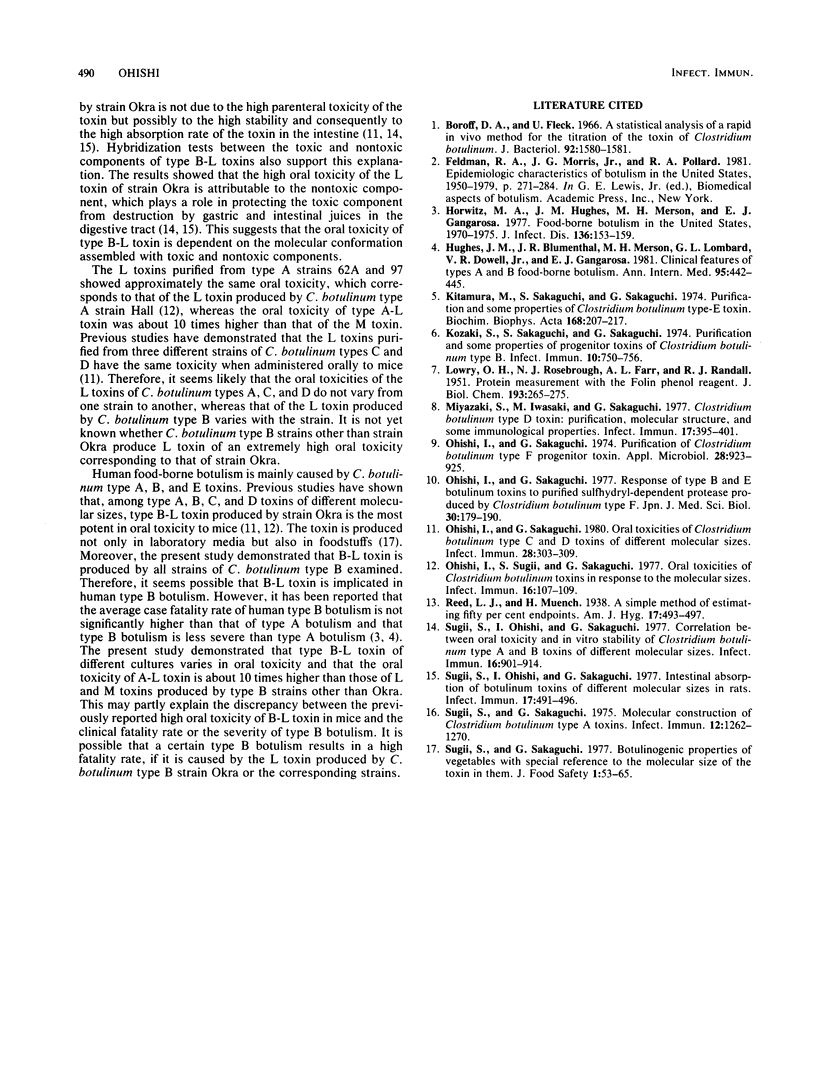Abstract
The production and the oral toxicity for mice of Clostridium botulinum type A and B toxins of different strains were studied. All five type B strains produced both 16S (large or L) and 12S (medium or M) toxins, although the relative amounts varied with the strains. The culture supernatant of type B Okra strain was the most potent in oral toxicity. The L toxin of this culture was about 700 times more toxic in feeding tests with mice than the L toxin from type B strain NH-2, whereas the M toxins of the two strains had the same oral toxicity. These results indicate that the oral toxicity of type B toxin varies with the culture strain. Oral toxicities of L toxin produced by type A strains 62A and 97 were comparable but were 10 times higher than those of their M toxins. Hybrids of toxic and nontoxic components separated from L toxins of type B strains Okra and NH-2 revealed that the high oral toxicity of the B-L toxin of strain Okra is attributable not to the toxic but to the nontoxic component of the toxin. The present study suggests that the 16S molecular-sized toxin elaborated by a certain strain of C. botulinum type B is implicated in the high fatality rate in type B human botulism.
Full text
PDF



Selected References
These references are in PubMed. This may not be the complete list of references from this article.
- Boroff D. A., Fleck U. Statistical analysis of a rapid in vivo method for the titration of the toxin of Clostridium botulinum. J Bacteriol. 1966 Nov;92(5):1580–1581. doi: 10.1128/jb.92.5.1580-1581.1966. [DOI] [PMC free article] [PubMed] [Google Scholar]
- Horwitz M. A., Hughes J. M., Merson M. H., Gangarosa E. J. Food-borne botulism in the United States, 1970-1975. J Infect Dis. 1977 Jul;136(1):153–159. doi: 10.1093/infdis/136.1.153. [DOI] [PubMed] [Google Scholar]
- Hughes J. M., Blumenthal J. R., Merson M. H., Lombard G. L., Dowell V. R., Jr, Gangarosa E. J. Clinical features of types A and B food-borne botulism. Ann Intern Med. 1981 Oct;95(4):442–445. doi: 10.7326/0003-4819-95-4-442. [DOI] [PubMed] [Google Scholar]
- Kitamura M., Sakaguchi S., Sakaguchi G. Purification and some properties of Clostridium botulinum type-E toxin. Biochim Biophys Acta. 1968 Oct 21;168(2):207–217. doi: 10.1016/0005-2795(68)90144-x. [DOI] [PubMed] [Google Scholar]
- Kozaki S., Sakaguchi S., Sakaguchi G. Purification and some properties of progenitor toxins of Clostridium botulinum type B. Infect Immun. 1974 Oct;10(4):750–756. doi: 10.1128/iai.10.4.750-756.1974. [DOI] [PMC free article] [PubMed] [Google Scholar]
- LOWRY O. H., ROSEBROUGH N. J., FARR A. L., RANDALL R. J. Protein measurement with the Folin phenol reagent. J Biol Chem. 1951 Nov;193(1):265–275. [PubMed] [Google Scholar]
- Miyazaki S., Iwasaki M., Sakaguchi G. Clostridium botulinum type D toxin: purification, molecular structure, and some immunological properties. Infect Immun. 1977 Aug;17(2):395–401. doi: 10.1128/iai.17.2.395-401.1977. [DOI] [PMC free article] [PubMed] [Google Scholar]
- Ohishi I., Sakaguchi G. Oral toxicities of Clostridium botulinum type C and D toxins of different molecular sizes. Infect Immun. 1980 May;28(2):303–309. doi: 10.1128/iai.28.2.303-309.1980. [DOI] [PMC free article] [PubMed] [Google Scholar]
- Ohishi I., Sakaguchi G. Response of type B and E Botulinum toxins to purified sulfhydryl-dependent protease produced by Clostridium botulinum type F. Jpn J Med Sci Biol. 1977 Aug;30(4):179–190. doi: 10.7883/yoken1952.30.179. [DOI] [PMC free article] [PubMed] [Google Scholar]
- Ohishi I., Sugii S., Sakaguchi G. Oral toxicities of Clostridium botulinum toxins in response to molecular size. Infect Immun. 1977 Apr;16(1):107–109. doi: 10.1128/iai.16.1.107-109.1977. [DOI] [PMC free article] [PubMed] [Google Scholar]
- Oishi I., Sakaguchi G. Purification of Clostridium botuliunum type F progenitor toxin. Appl Microbiol. 1974 Dec;28(6):923–928. doi: 10.1128/am.28.6.923-928.1974. [DOI] [PMC free article] [PubMed] [Google Scholar]
- Sugii S., Ohishi I., Sakaguchi G. Correlation between oral toxicity and in vitro stability of Clostridium botulinum type A and B toxins of different molecular sizes. Infect Immun. 1977 Jun;16(3):910–914. doi: 10.1128/iai.16.3.910-914.1977. [DOI] [PMC free article] [PubMed] [Google Scholar]
- Sugii S., Ohishi I., Sakaguchi G. Intestinal absorption of botulinum toxins of different molecular sizes in rats. Infect Immun. 1977 Sep;17(3):491–496. doi: 10.1128/iai.17.3.491-496.1977. [DOI] [PMC free article] [PubMed] [Google Scholar]
- Sugii S., Sakaguchi G. Molecular construction of Clostridium botulinum type A toxins. Infect Immun. 1975 Dec;12(6):1262–1270. doi: 10.1128/iai.12.6.1262-1270.1975. [DOI] [PMC free article] [PubMed] [Google Scholar]


